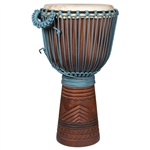Taking Care of your Djembe
Proper care of your djembe drum will ensure that it's consistently performing well and looking great. One of the easiest and most beneficial tips is to detune your djembe when not using it for an extended period of time. Due to the high amount of tension that is placed on the skin, it's often a good idea to detune the drum from time to time. Detuning will prolong the longevity of the skin and most likely extend the life of your drumhead by another 50%. By adding or subtracting diamonds of Mali weave, you can tune or detune your drum. The more often you do it the quicker you'll get at adding or subtracting knots. So, learn now and get in the habit.
Another tip to properly take care of your djembe is to rub a small amount of shea butter on the skin if and when it becomes excessively dry. Adding a small amount will help improve the tonality of your drum and also assists in improving the life of the skin. If possible it's also a good idea to store your djembe in a cool, dry place and avoid leaving your drum exposed to direct sunlight. A good place to store your drum is in your djembe bag. Make it a habit of leaving your djembe in the bag when not using it. Which leads me to my third point. Invest in a quality djembe bag.
A djembe is an instrument and like any instrument should be properly maintained. This includes getting a bag for transporting your drum from place to place. If you plan on lugging your drum all over, and doing a lot of gigging, I would recommend investing in a bag that offers padded protection all the way around your drum. These bags are typically more expensive however they are well worth the investment. If you don't plan on transporting your drum too frequently you can probably get by with a cloth bag. Cloth djembe bags typically don't offer padding; however do serve the general purpose of offering protection during the transporting of your drum. Another positive for cloth bags is they are usually offered in a variety of color combinations.
One more point about djembe bags. Be sure to invest in a bag that fits your drum snugly. A bag that is too large for your djembe will not offer the proper protection it should as compared with a bag that fits your drum tightly. Now with that being said I typically find that people too often purchase a bag that is too small for their drum. Make sure you measure you drum correctly by taking into consideration the entire head size not just the playing surface size when sizing up a djembe bag.
Your djembe is an investment. By adhering to some simple maintenance guidelines you will get years of enjoyment out of your drum by ensuring that it's performing and looking great!
Djembe Buying Guide
2. Djembe Wood Source & Lathing [Video]
3. Djembe Shell Carving & Painting [Video]
5. Which Size Djembe is Right for Me? [Video]
6. Key Tuned vs. Rope Tuned Djembe
7. Djembe Drum: Wood vs. Synthetic
8. How to Tune a Djembe [Video]
10. A Note About African Djembes
11. Djembe Rhythm Exercises [Video]
12. Djembe Rope. Why Quality Matters.
13. Taking Care of your Djembe
15. How to Play the Djembe [Video]
16. Play the Djembe is Easy for All!
Recent Posts
-
X8 Drums Play-Along Backing Tracks
The new X8 Play-Along Series is being produced for our musician friends wanting a fresh way to work …9th Feb 2025 -
What is the Best Size Djembe for Beginners?
If you're new to the world of percussion and interested in learning the djembe, you're in for a t …16th Jul 2024 -
The Benefits of Becoming a Drumming Teacher: Transforming Passion into Profession
Why become a drumming teacher? Becoming a drumming teacher is an excellent way to share your pas …22nd May 2024




